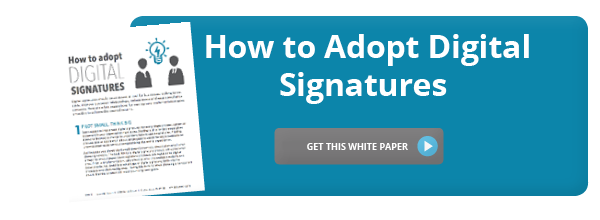Agents are the lifeblood of the insurance industry – and they work hard for their commissions.
In a stiff market, agents pour many hours into beginning relationships, building trust and communicating how their services will help clients mitigate risk in the unforeseeable future. After this preliminary work, when it’s time to close a deal, getting a signature is the home stretch, but it can take a while to cross the finish line.
how their services will help clients mitigate risk in the unforeseeable future. After this preliminary work, when it’s time to close a deal, getting a signature is the home stretch, but it can take a while to cross the finish line.
Currently, an insurance agent has to:
- Gather all application information from the prospective consumer.
- Generate and print an Association for Cooperative Operations Research and Development (ACORD) compliant application.
- Deliver or send the application to the client—either by mail, fax or email—for the client to print out, sign and return, again either through mail, fax or email.
- Send the signed application to the insurance company and file the client document.
Completing the last leg of an insurance sale can easily get bogged down by all of the paper documents floating around...not to mention the cost of printing and sending said documents. In a world where consumers have become used to near-immediacy in many of their transactions, a time-consuming process is unappealing; nor does an insurance company want to spend any more money than absolutely necessary when processing applications.
So, what can the adoption of e-signatures provide insurance agents that will improve sales cycles?
Mobility. Face-to-face meetings are the bread and butter of insurance sales, and mobile technology works well with this way of doing business. Many agents are equipped with tablets and laptops that provide immediate access to applications when working with clients in the field.
A key part of any application or claim, of course, is the signature. Because e-signatures deployed through the cloud, like Independent E-Signatures™, allow transactions to happen almost immediately (and securely) on virtually any mobile device, these discussions don’t have to be taken back to the office for paperwork to begin. When the customer is ready – so is the agent.
Good order. E-signature technology is logic-based, meaning it can stop a transaction from moving forward if document fields are left blank or if something isn’t signed correctly. If e-signatures for insurers are integrated into CRM systems or Automated Order Entry systems, there’s also another level to consistent flow of data. Such technologies can improve the accuracy and good order of documents, which saves a lot of time and hassle.
Getting back to business. Because e-signatures for insurers can swiftly expedite sales processes and other transactions, agents have more time to spend building relationships with current and potential clients. Since the entire process can be automated, agents are more efficient and productive – and clients are happier. And once you take into account all of the costs associated with paper—printing, ink, toner, shipping, etc.—this adds up to significant cost-savings.
Doesn’t sound too bad, does it?
To dig deeper into how insurance agents can adopt e-signatures, download our free white paper!
%20formatted-1.png?width=2528&height=739&name=SIGNiX%20Logo%20Main%20(white)%20formatted-1.png)

